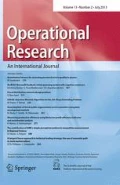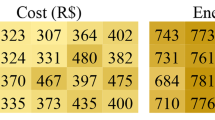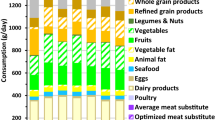Abstract
Last reviews show how the Spanish consumption patterns have become away from the Mediterranean diet, traditionally consumed in Spain and widely supported by the nutritional expert community. Hence, the aim of this study is to explore and provide different alternatives to the current Spanish diet. The idea is to obtain a set of palatable diets fulfilling the nutritional requirements and conform the Mediterranean standards, while staying as close as possible to the current population pattern, under a budget constraint. In this context, different models are developed using multiobjective techniques. Additionally, this work defines an alternative diet more stable in comparison with the diets on the boundary of the feasible set. The consumption data used in this study is taken from Ministerio de Agricultura y Pesca, Alimentación y Medio Ambiente (in Spanish MAPAMA) that contains relevant information about the foods consumed in Spain. Using this data, each model has been solved with Matlab Software, obtaining different feasible diets, whose composition corresponds to the suggested daily intake for a Spanish adult. In any case, the budget constraint reduces the current cost and fulfills the nutritional requirements, attending to the Mediterranean standards. Results show different food baskets to guide the current Spanish diet towards the consumption of healthy foods in the appropriate proportions, going back to the diet traditionally consumed.




Similar content being viewed by others
References
AECOSAN (Agencia Española de Consumo, Seguridad Alimentaria y Nutrición) (2011) Encuesta Nacional de Ingesta Dietética Española. http://www.cibr.es/ka/apps/cibr/docs/estudio-enide-1.pdf. Accessed Jan 2016
Bach-Faig A, Berry EM, Lairon D, Reguant J, Trichopoulou A, Dernini S et al (2011) Mediterranean diet pyramid today. Science and cultural updates. Public Health Nutr 14(12A):2274–2284
Baourakis G, Baltas G, Izmiryan M, Kalogeras N (2007) Brand preference: a comparative consumer study in selected EU countries. Oper Res Int Journal 7(1):105–120
Benedetti I, Biggerib L, Lauretic T, Secondid L (2016) Exploring the Italians’ food habits and tendency towards a sustainable diet: the Mediterranean eating pattern. Agric Agric Sci Procedia 8:433–440
Bonaccio M, Iacoviello L, de Gaetano G (2012) The Mediterranean diet: the reasons for a success. Thromb Res 129:401–404
Bonaccio M, Bes-Rastrollo M, de Gaetano G, Iacoviello L (2016) Challenges to the Mediterranean diet at a time of economic crisis. Nutr Metab Cardiovasc Dis 26:1057–1063
Briend A, Darmon N, Ferguson E, Erhardt J (2003) Linear programming: a mathematical tool for analyzing and optimizing children´s diets during the complementary feeding period. J Pediatr Gastroenterol Nutr 36:12–22
Buttriss JL, Briend A, Darmon N, Ferguson EL, Maillot M, Lluch A (2014) Diet modelling: how it can inform the development of dietary recommendations and public health policy. Nutr Bull 39:115–125
Carlson A, Lino M, Fungwe T (2007) The low-cost, moderate-cost, and liberal food plans, 2007 (CNPP-20). Department of Agriculture, Center for Nutrition Policy and Promotion, Washington
Conforti P, D’Amicis A (2000) What is the cost of a healthy diet in terms of achieving RDAs? Public Health Nutr 3:367–373
Darmon N, Ferguson EL, Briend A (2002) A cost constraint alone has adverse effects on food selection and nutrient density: an analysis of human diets by linear programming. J Nutr 132(12):3764–3771
Darmon N, Ferguson EL, Briend A (2006) Impact of a cost constraint on nutritionally adequate food choices for French women: an analysis by linear programming. J Nutr Educ Behav 38(2):82–90
del Pozo S, García-Iglesias V, Cuadrado-Vives G, Ruiz-Moreno E, Valero-Gaspar T, Ávila-Torres JM, Varela-Moreiras G (2013) Valoración nutricional de la dieta española de acuerdo al Panel de Consumo Alimentario. Ministerio de Agricultura, Alimentación y Medio Ambiente, Madrid
Dhoruri A, Lestari D, Ratnasari E (2017) Sensitivity analysis of Goal Programming model for dietary menu of diabetes mellitus patients. Int J Model Optim 7(1):7–12
Ferguson EL, Darmon N, Briend A, Premachandra IM (2004) Food-based dietary guidelines can be developed and tested using linear programming analysis. J Nutr 134:951–957
Ferguson EL, Darmon N, Fahmida U, Fitriyanti S, Harper TH, Premachandra IM (2006) Design of optimal food-based complementary feeding recommendations and identification of key “problem nutrients” using Goal Programming. J Nutr 136(9):2399–2404
Fletcher LR, Soden PM, Zinober ASI (1994) Linear programming techniques for the construction of palatable human diets. J Oper Res Soc 45(5):489–496
Gao X, Wilde PE, Lichtenstein AH, Tucker L (2006) The 2005 USDA Food Guide Pyramid is associated with more adequate intakes within energy constraints than the 1992 Pyramid. J Nutr 136:1341–1346
García-Meseguer MJ, Cervera F, Vico C, Serrano-Urrea R (2014) Adherence to Mediterranean diet in a Spanish university population. Appetite 78:156–164
Gerdessen JC, de Vries JHM (2015) Diet models with linear Goal Programming: impact of achievement functions. Eur J Clin Nutr 69:1272–1278
Gerdessen JC, Claasen GDH, Banasik A (2013) General 0–1 fractional programming with conditional fractional terms for design of food frequency questionnaires. Oper Res Lett 411:7–11
Gerdessen JC, Kanellopoulos A, Claassen GDH (2018) “Combinig equity and utilitarianism”—additional insights into a novel approach. Int Trans Oper Res 25:7–11
Germani A, Vitiello V, Giusti AM, Pinto A, Donini LM, del Balzo V (2014) Environmental and economic sustainability of the Mediterranean diet. Int J Food Sci Nutr 65(8):1008–1012
Hollander M, Wolfe DA (1999) Nonparametric statistical methods. Wiley, Hoboken
Hooker JN, Williams HP (2012) Combining equity and utilitarianism in a mathematical programming model. Manage Sci 58:1682–1693
Horgan GW, Perrin A, Whybrow S, Macdiarmid JI (2016) Achieving dietary recommendations and reducing greenhouse gas emissions: modelling diets to minimise the change from current intakes. Int J Behav Nutr 13:1–11
Iaccarino P, Scalfi L, Valerio G (2017) Adherence to the Mediterranean diet in children and adolescents: a systematic review. Nutr Metab Cardiovasc Dis 27:283–299
Lancaster LM (1992) The history of the application of mathematical programming to menu planning. Eur J Oper Res 57:339–347
Latasa ML, Louzada E, Martinez Steele CA, Monteiro P (2018) Added sugars and ultra-processed foods in Spanish households (1990–2010). Eur J Clin Nutr 72:1404–1412
Levesque S, Delisle H, Agueh V (2014) Contribution to the development of a food guide in Benin: linear programming for the optimization of local diets. Public Health Nutr 18(4):622–631
Maderuelo-Fernández JA, Recio-Rodríguez J, Patino-Alonso MC, Pérez-Arechaedra D, Rodríguez-Sánchez E, Gómez-Marcos MA, García-Ortiz L (2015) Effectiveness of interventions applicable to primary health care settings to promote Mediterranean diet or healthy adherence in adults: a systematic review. Prev Med 76:S39–S45
Maillot M, Ferguson EL, Drewnowski A, Darmon N (2008) Nutrient profiling can help identify foods of good nutritional quality for their price: a validation study with linear programming. J Nutr 138(6):1107–1113
Maillot M, Vieux F, Amiot MJ, Darmon N (2010) Individual diet modeling translates nutrient recommendations into realistic and individual-specific food choices. Am J Clin Nutr 91:421–430
MAPAMA (Ministerio de Agricultura y Pesca, Alimentación y Medio Ambiente). (2013) Base de Datos de Consumo en hogares. http:// www.mapama.gob.es/es/alimentacion/temas/consumo-y-comercializacion-y-distribucion-alimentaria/panel-de-consumo-alimentario/base-de-datos-de-consumo-en-hogares/consulta.asp. Accessed Jan 2016
Masset G, Monsivais P, Maillot M, Darmon N, Drewnowski A (2009) Diet optimization methods can help translate dietary guidelines into a cancer prevention food plan. J Nutr 139:1541–1548
Mertens E, van’t Veer p, Hiddink GJ, Steijns J, Kuijsten A (2016) Operationalising the health aspects of sustainable diets: a review. Public Health Nutr 20:739–757
Metzgar M, Rideout TC, Fontes-Villalba M, Kuipers RS (2011) The feasibility of a Paleolithic diet for low-income consumers. Nutr Res 3:444–451
Moreiras O, Carbajal A, Cabrera L, Cuadrado C (2016) Tablas de composición de alimentos. Guía de Prácticas, 18ª edn. Ediciones Pirámide, Madrid
Muros JJ, Cofre-Bolados C, Arriscado D, Zurita F, Knox E (2017) Mediterranean diet adherence is associated with lifestyle, physical fitness, and mental wellness among 10-y-olds in Chile. Nutrition 35:87–92
Romero C (1991) Handbook of critical issues in Goal Programming. Pergamon Press, Oxford
Romero C (2001) Extended lexicographic Goal Programming: a unifying approach. Omega 29:63–71
Romero C (2004) A general structure of achievement function for a Goal Programming model. Eur J Oper Res 153:675–686
SENC (Sociedad Española de Nutrición Comunitaria) (2011) Objetivos nutricionales para la población española. Rev Esp Nutr Comunitaria 17(4):178–199
Serra-Majem L, Bes-Rastrollo M, Román-Viñas B, Pfrimer K, Sánchez-Villegas A, Martínez-González MA (2009) Dietary patterns and nutritional adequacy in a Mediterranean country. Br J Nutr 101(S2):S21–S28
Shankar B, Srinivasan CS, Irz X (2008) World Health Organization dietary norms: a quantitative evaluation of potential consumption impacts in the United States, United Kingdom, and France. Rev Agric Econ 30(1):151–175
Smith VE (1959) Linear programming models for the determination of palatable human diets. J Farm Econ 41:272–283
Srinivasan CS (2007) Foods consumption impacts of adherence to dietary norms in the United States: a quantitative assessment. Agric Econ 37:249–256
Steuer RE, Choo E-H (1983) An interactive weighted Tchebycheff procedure for multiple objective programming. Math Program 26:326–344
Stigler GJ (1945) The cost of subsistence. J Farm Econ 27(2):303–314
UNESCO (2013) Representative list of the intangible cultural heritage of humanity. https://ich.unesco.org/en/RL/mediterranean-diet-00884. Accessed June 2018
Varela-Moreiras G, Ávila-Torres JM, Cuadrado-Vives C, del Pozo S, Ruiz-Moreno E, Moreiras-Tuny O (2008) Valoración de la dieta española de acuerdo al panel de consumo alimentario. Ministerio de Agricultura, Alimentación y Medio Ambiente, Madrid
Varela-Moreiras G, Avila JM, Cuadrado C, del Pozo S, Ruiz E, Moreiras O (2010) Evaluation of food consumption and dietary patterns in Spain by the Food Consumption Survey: updated information. Eur J Clin Nutr 64(3):S37–S43
WHO (2003) Diet, nutrition and the prevention of chronic diseases: report of a join WHO/FAO expert consultation. Technical report series no 916. World Health Organization
WHO (2015) Guideline: sugars intake for adults and children. World Health Organization, Geneve
Wilde P, Llobrera J (2009) Using the Thrifty Food Plan to assess the cost of a nutritious diet. J Consum Aff 43(2):274–304
Willett WC, Sacks F, Trichopoulou A, Drescher G, Ferro-Luzzi A, Helsing E, Trichopoulos D (1995) Mediterranean diet pyramid: a cultural model for healthy eating. Am J Clin Nutr 61(6):1402S–1406S
Acknowledgements
The authors wish to express their gratitude to the referees for their valuable and helpful comments which have contributed to improve the quality of the paper. This work was supported by the Ministerio de Ciencia, Innovación y Universidades from Spain [ECO2016-76567-C4-4-R] with a Grant (BES-2014-068507) and by the Consejería de Conocimiento, Investigación y Universidad from Andalucia [SEJ417].
Author information
Authors and Affiliations
Corresponding author
Additional information
Publisher's Note
Springer Nature remains neutral with regard to jurisdictional claims in published maps and institutional affiliations.
Appendices
Appendix 1: Complete models
EGP model
Hard constraints
TGP model
Hard constraints
Appendix 2: Supplementary material
See Tables 5, 6, 7, 8, 9, 10 and Fig. 5.
Rights and permissions
About this article
Cite this article
Hernández, M., Gómez, T., Delgado-Antequera, L. et al. Using multiobjective optimization models to establish healthy diets in Spain following Mediterranean standards. Oper Res Int J 21, 1927–1961 (2021). https://doi.org/10.1007/s12351-019-00499-9
Received:
Revised:
Accepted:
Published:
Issue Date:
DOI: https://doi.org/10.1007/s12351-019-00499-9





